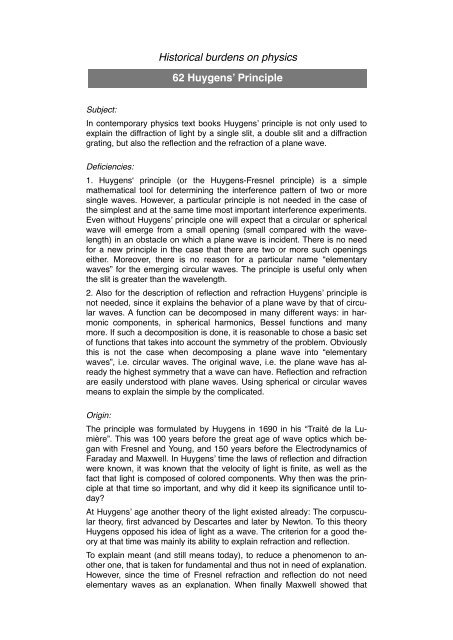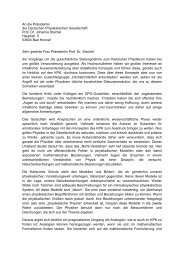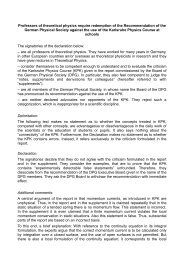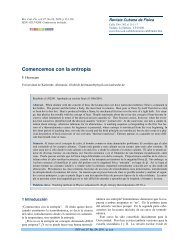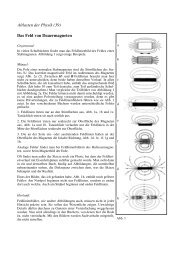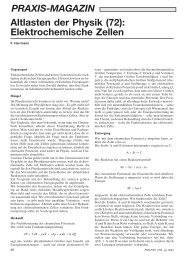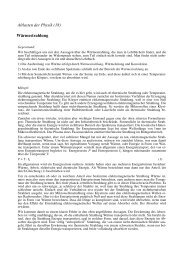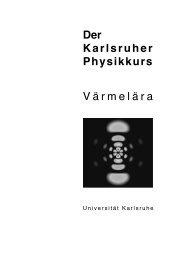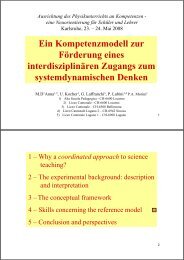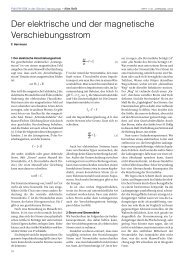Historical burdens on physics 62 Huygens' Principle
Historical burdens on physics 62 Huygens' Principle
Historical burdens on physics 62 Huygens' Principle
You also want an ePaper? Increase the reach of your titles
YUMPU automatically turns print PDFs into web optimized ePapers that Google loves.
<str<strong>on</strong>g>Historical</str<strong>on</strong>g> <str<strong>on</strong>g>burdens</str<strong>on</strong>g> <strong>on</strong> <strong>physics</strong><br />
<strong>62</strong> Huygens’ <strong>Principle</strong><br />
Subject:<br />
In c<strong>on</strong>temporary <strong>physics</strong> text books Huygens’ principle is not <strong>on</strong>ly used to<br />
explain the diffracti<strong>on</strong> of light by a single slit, a double slit and a diffracti<strong>on</strong><br />
grating, but also the reflecti<strong>on</strong> and the refracti<strong>on</strong> of a plane wave.<br />
Deficiencies:<br />
1. Huygens‘ principle (or the Huygens-Fresnel principle) is a simple<br />
mathematical tool for determining the interference pattern of two or more<br />
single waves. However, a particular principle is not needed in the case of<br />
the simplest and at the same time most important interference experiments.<br />
Even without Huygens’ principle <strong>on</strong>e will expect that a circular or spherical<br />
wave will emerge from a small opening (small compared with the wavelength)<br />
in an obstacle <strong>on</strong> which a plane wave is incident. There is no need<br />
for a new principle in the case that there are two or more such openings<br />
either. Moreover, there is no reas<strong>on</strong> for a particular name “elementary<br />
waves” for the emerging circular waves. The principle is useful <strong>on</strong>ly when<br />
the slit is greater than the wavelength.<br />
2. Also for the descripti<strong>on</strong> of reflecti<strong>on</strong> and refracti<strong>on</strong> Huygens’ principle is<br />
not needed, since it explains the behavior of a plane wave by that of circular<br />
waves. A functi<strong>on</strong> can be decomposed in many different ways: in harm<strong>on</strong>ic<br />
comp<strong>on</strong>ents, in spherical harm<strong>on</strong>ics, Bessel functi<strong>on</strong>s and many<br />
more. If such a decompositi<strong>on</strong> is d<strong>on</strong>e, it is reas<strong>on</strong>able to chose a basic set<br />
of functi<strong>on</strong>s that takes into account the symmetry of the problem. Obviously<br />
this is not the case when decomposing a plane wave into “elementary<br />
waves”, i.e. circular waves. The original wave, i.e. the plane wave has already<br />
the highest symmetry that a wave can have. Reflecti<strong>on</strong> and refracti<strong>on</strong><br />
are easily understood with plane waves. Using spherical or circular waves<br />
means to explain the simple by the complicated.<br />
Origin:<br />
The principle was formulated by Huygens in 1690 in his “Traité de la Lumière”.<br />
This was 100 years before the great age of wave optics which began<br />
with Fresnel and Young, and 150 years before the Electrodynamics of<br />
Faraday and Maxwell. In Huygens’ time the laws of reflecti<strong>on</strong> and difracti<strong>on</strong><br />
were known, it was known that the velocity of light is finite, as well as the<br />
fact that light is composed of colored comp<strong>on</strong>ents. Why then was the principle<br />
at that time so important, and why did it keep its significance until today?<br />
At Huygens’ age another theory of the light existed already: The corpuscular<br />
theory, first advanced by Descartes and later by Newt<strong>on</strong>. To this theory<br />
Huygens opposed his idea of light as a wave. The criteri<strong>on</strong> for a good theory<br />
at that time was mainly its ability to explain refracti<strong>on</strong> and reflecti<strong>on</strong>.<br />
To explain meant (and still means today), to reduce a phenomen<strong>on</strong> to another<br />
<strong>on</strong>e, that is taken for fundamental and thus not in need of explanati<strong>on</strong>.<br />
However, since the time of Fresnel refracti<strong>on</strong> and reflecti<strong>on</strong> do not need<br />
elementary waves as an explanati<strong>on</strong>. When finally Maxwell showed that
light is an electromagnetic wave and described it mathematically Huygens’<br />
elementary waves definitely became obsolete, even though it was not clear<br />
why it should be valid for the complicated electromagnetic transverse<br />
waves. Only Kirchhoff succeeded in showing the compatibility of Huygens’<br />
principle with the electromagnetic theory.<br />
The role which Huygens’ principle plays today at the school and the University<br />
is still marked by its former importance. Just as Lenz’ law or Kepler’s<br />
laws, it has survived its own more general follow-up laws. It is true that it<br />
still is a useful method for an approximate determinati<strong>on</strong> of interference patterns,<br />
but as such we should put it together with the many other tools of<br />
<strong>physics</strong> and not call it a principle.<br />
Disposal:<br />
To explain the diffracti<strong>on</strong> at the single slit and the interference pattern of the<br />
double slit and the grating, no particular principle is needed. If <strong>on</strong>e cannot<br />
decide to let the treatment of the large slit to the university, then <strong>on</strong>e may<br />
introduce Huygens’ principle, but with a more modest demeanor.<br />
Friedrich Herrmann, Karlsruhe Institute of Technology


